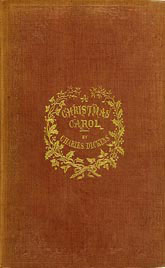A Christmas Carol
Critique • Text • At the movies
 First edition
First editionOriginal title
A Christmas Carol. In Prose. Being a Ghost Story of Christmas.
First publication
1843
Literary form
Novella
Genres
Literary
Writing language
English
Author's country
England
Length
Approx. 28,000 words

Seymour Hicks, right, created the cinematic character of Ebenezer Scrooge in the 1935 film.
Birth of a classic crank
Scrooge (1935): Film, 78 minutes; director Henry Edwards; writer H. Fowler Mear; featuring Seymour Hicks, Donald Calthrop, Oscar Asche
Video versions of Charles Dickens's A Christmas Carol are so ubiquitous today, especially on television around the holiday season, that it may be surprising to learn that film studios at first resisted making any.
Throughout the silent era, several shorts—of 15 minutes or less—were based on Dickens's beloved story. Even in the early sound years when classic adaptations were being cranked out, the seasonal theme of A Christmas Carol was a hard sell, due to the slow distribution system then. Such a film could be shown in only a few major cities before the season passed.
Bucking the trend however was prominent British stage actor Seymour Hicks, who from a young age practically made a career of playing the old miser Ebenezer Scrooge. In addition to his theatre adaptations, he is credited with writing and starring in a forty-minute silent film in 1913 when he was little older than forty.
Over two decades later, when he was closer to the character's age Hicks finally got his fellow Brits to commit to a full-length, big-screen production of the story. Though actually based on a stage play by H. Fowler Mear, Scrooge (1935) adheres closely to Dickens's vision, except for a few extraneous religious and sentimental touches.
Best Scrooge ever?
Although it's usually overlooked, Hicks's film laid down a pattern for all future cinematic Christmas Carols. You can especially see the seeds of Alistair Sim's popular 1951 rendition of Scrooge in Hicks's portrayal of the lead character, a rumpled old man with fly-away white hair and a constricted body language. Before our eyes, he grows gradually from cruelly arrogant misanthropy to meek generosity teetering on self-conscious giddiness.
Some have argued Hicks makes the best Scrooge ever.
The story in his film is still somewhat compressed however. In the Christmas Past section we don't get to see the childhood that shaped Scrooge or his early adult life as business partner with Morley.
When Morley's ghost appears to Scrooge, he's invisible to us, leaving sound effects and Hicks's estimable acting to create the desired impression. Of the three Christmas spirits, only Christmas Present, in the memorable person of Shakespearean actor Oscar Asche, is shown clearly, the other two being indicated by lights and shadows.
For modern viewers, the film experience may also be hampered by the scratchy and chopped up quality of the copies that occasionally show up on television. But recently restored and colorized versions are now available, hopefully bringing this seminal Scrooge back into the limelight it deserves.
Whatever copy you find though, its dark depiction of Victorian England, the even darker depiction of a tortured soul, and the excellent acting all-round bring this Scrooge alive as a more-than-worthwhile early example of the genre.
— Eric

